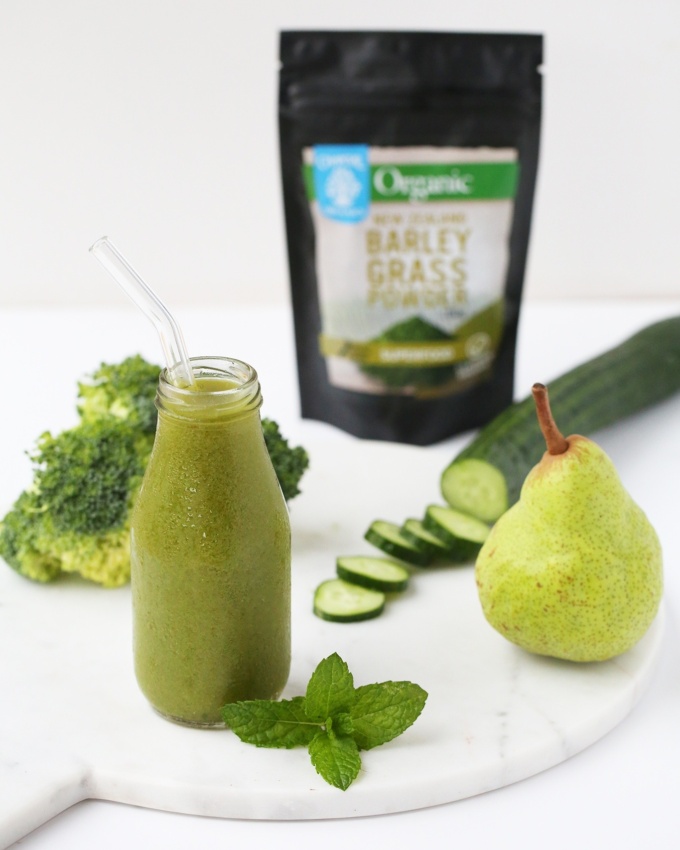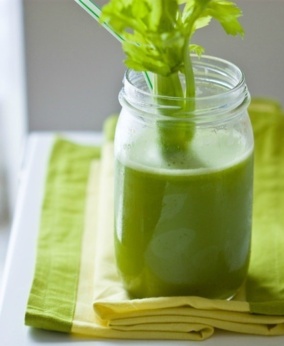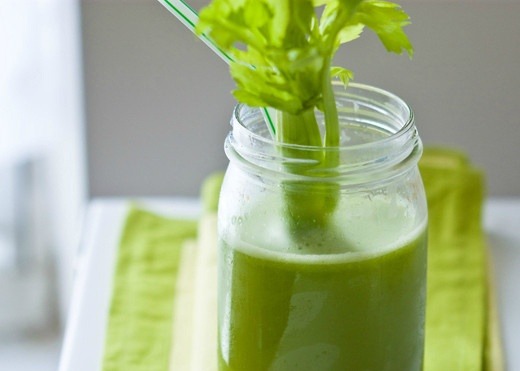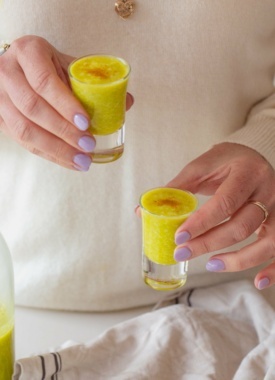
Green juicing is one of the hottest things in the natural health world right now. Made the right way, it can also be downright delicious. But for those of you who are just starting out, it can seem a bit intimidating (or just odd). The secret is – it’s really actually rather easy. What’s more, once you’ve experienced the thrill of that nutrient-rich life-giving green elixir running through your veins, you might just be hooked.
So what exactly is green juice, why would you want to drink it, and how can you whizz one up yourself (without paying $10 at your local health food store)? Read on dear friend:
What is “Green Juice”?
Green juice is juice made predominantly out of green vegetables, with a hint of fruit for sweetness. To get the maximum benefits from your juice, you’ll want to aim for a vege to fruit ratio of around 3:1. When you’re starting out however, you might want to include a bit more fruit until your tastebuds get used to it.
Why would I want to drink it?
1. Absorb All The Good Nutrients Straight Away
When you juice any type of produce you essentially remove all the fibre, leaving just the vitamins, minerals, living enzymes and nutrients. Now don’t get me wrong, fibre is a good thing, but when you’re eating an organic whole foods plant-based diet, you’ll be getting enough of that to keep your insides chugging along quite nicely.
By removing the fibre from the produce, your body is able to absorb and assimilate all the life-giving phyto-nutrients (plant nutrients) straight away. This is because it doesn’t have to work its way through digesting all that fibre first.
Note: If your juice is packed full of sugar (like unfortunately most of the juice available in supermarkets), this is not such a good thing, as you’ll effectively be giving yourself a shot of instant glucose. Great for someone about to run a marathon; not for the sedentary majority of us.
2. Give Your Digestive System a Break
The other great thing about removing the fibre from produce, is it gives your body’s digestive system a break. This can be particularly good if you have an illness, even if it’s just the flu. Drinking a juice full of fruit and vegetables will mean your cells can effectively absorb all the disease-fighting nutrients, even in the body’s weakened state. It’s for this reason that many alternative natural cancer therapies include fresh fruit and vegetable juicing as a key part of their treatment methods.
3. Get Your 5+ a Day in a Single Glass
Another benefit of green juicing, is you get a lot of phyto-nutrients, vitamins and minerals in a single glass. Sure, you could eat two stalks of celery, a bunch of silverbeet, a brocolli stalk, an apple, half a lime, and a bunch of parsley, but most of us don’t have the time (or patience) for that. Green juicing means you can consume that 5+ a day in one go, before you’ve even left the house. Especially useful on days when you know you’re going to be faced with some less healthy food choices. Or try one the morning after a big night – it’s one of the best hangover cures you’ll find.
4. Cure Illness, Slow Aging, Improve Skin, Lose Weight
Green vegetables are a high source of chlorophyll, which purifies the bloodstream as well as cleanses the liver and kidneys. Furthermore, the unadulterated vitamins and minerals found in plants have been proven numerous times over to cure illness, slow aging, enhance the appearance of skin, eyes and hair, improve digestion, and help with healthy weight management. Maybe that’s why Ma always told us to eat our greens!

How do I make it?
1. Get Yourself a Slow Juicer
The first thing you’ll want to do is get yourself a slow juicer. Why slow you ask? A regular high-speed juicer exposes the fruit and vegetables to a lot of stress and heat friction, which destroys some of the valuable nutrients. It also adds a lot of air to the juice, which means the enzymes oxidise a lot quicker, again leading to a loss of nutrients. High-speed juicers also tend to produce a lower yield, with much more foam on the top and an inferior consistency.
In contrast, slow juicers gently squeeze the fruit and vegetables at a low speed, much like our grandparents would have done with their hand-squeezed grapefruit juice. The result is no frictional heat destruction, significantly lower oxidation from aeration, very limited nutrient loss, scientifically proven higher levels of phyto-chemicals and vitamins, a smoother consistency, less froth, and a better tasting juice. If you’re investing in organic fruit & vege, you’ll no doubt be wanting to get the most out of your produce too.
2. Buy Organic Fruit & Veggie
When you remove all the fibre from your produce, you’re getting a concentrated shot of what’s inside. Thus you’ll want to avoid conventional produce from the supermarket or vege store that has been repeatedly sprayed with pesticides and chemicals. Or at the very least, wash your produce thoroughly before using.
Tip: Straight after your shop, fill your kitchen sink with warm water, squeeze in half an organic lemon or 1 tablespoon of organic apple cider vinegar, pour all your produce in and leave it to soak for half an hour, then scrub/rub each item and dry off in a colander before putting back in the fridge/cupboard.
The US based Environmental Working Group (EWG) produces a handy guide each year on which produce items have been scientifically tested to contain the most pesticides. The “Dirty Dozen” reflects the 12 items containing the most pesticides, while the “Clean Fifteen” reflect the 15 items with the least contamination. The idea being you can get away with buying the Clean Fifteen as conventional/sprayed produce, while the Dirty Dozen you should aim to buy organic. While the guide isn’t as applicable to other countries outside the US, it does still hold true for imported produce. Also, spraying practices on particular crops (like apples), are similar across countries, therefore a New Zealand or Australian apple is likely to be contaminated with similar sprays as a US one.
A key guideline – if you’re eating the skin (such as apples and spinach), then buy organic. If you’re peeling the skin (such as avocados, bananas, oranges), then it’s easier to get away with conventional plus washing. Clearly buying all organic is the safest, healthiest, and best option for our environment. A side benefit is it also encourages you to venture into trying more seasonal produce – this year alone I’ve explored yams, turnips, Maori Potatoes, broad beans and whole artichokes!
3. The Ultimate Green Juicing Formula
Here’s a fail proof step by step method to creating your perfect green juice. Once you’ve got the rhythm there are hundreds of potential combinations:
- Pick a water-rich green (cucumber, cos lettuce, brocolli stalks, celery)
- Add a green leafy (spinach, kale, silverbeet)
- Add some fruit (apple, pear, kiwifruit, orange)
- Add some herbs (parsley, coriander, mint)
- Add some zing (ginger, lemon, lime)
- Add some superfoods (Good Green Stuff, spirulina, gubinge, camu camu)
Or try this recipe for my favourite Mojito Juice:
THIS WEEK’S BE GOOD CHALLENGE:
Give a green juice a go. If you don’t have a slow juicer yet, click here to order my favourite, the Hurom 700 Slow Juicer.














Ingredients
- 1 small cucumber
- 2 stalks celery
- 2 leaves cos lettuce
- 1 apple
- 1 sprig mint
- 1/2 lime skin on
- 2 tsp Good Green Stuff optional
Instructions
- Place all items through your slow juicer, adding 1 cup of water at the end to wash through the remaining juice. Then stir through your supergreens powder at the end for an added nutrient kick.
- Serve with ice immediately, or put in a sealed jar and drink within 24 hours.
Equipment
- Juicer
Recipe Notes
- Add you choice of fav leafy green and other fruits/veges to make your version of this Mojito
- It’s best to make the juice fresh to drink rather than fridge for later, in order to get the full nutritional benefits.





